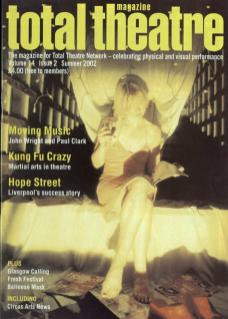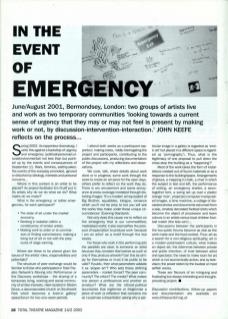I write this against a backdrop of urgency and emergency (political/personal/cultural/environmental) not less than but pointed up by the events and consequences of September 11. Wars, famines, earthquakes: the events of the everyday promoted, ignored or distorted by ideology, interests and personal concerns...
Where in this context is an artist to be placed? As project facilitator Em Druiff put it: ‘As artists why do we do what we do? What marks do we make?'
What is the emergency, or rather emergencies, for each participant?
- The state of art under the market economy.
- Working in isolation within a constituency of similar artists.
- Making work to order or to commission or finding commissions, making a living out of art or not with the pressures of wage earning.
Where are these to be placed given the issues of the artists' roles, responsibilities and potentials?
The structure of peer exchange would be familiar to those who participated in Total Theatre Network's Moving into Performance or the Discovery workshops – the sharing of a temporary living, working and social community of similar interests. Here, located in Dilston Grove, a deconsecrated church on Southwark Park which becomes a lived in gallery/space/forum for two one-week periods.
I attend both weeks as a participant-rapporteur, making notes, mildly interrogating the project and participants, contributing to the public discussions, producing documentation of the project with my reflections and observations.
We cook, talk, share details about work done or in progress: some work through the week to create an art piece for the open days, others prefer to reflect on the work they do. There is wry amusement and some annoyance at press coverage mediated through distorting images: 'It's a modem art equivalent of Big Brother; squabbles, intrigue, romance which you'll not be privy to but you will see the works they make under these unique circumstances.' (Evening Standard).
Not only does this cause me to reflect on the emergency that is our commodified, mediatised world; it also exemplifies the pressure of expectation to produce work 'because I am an artist' as a motif through the two weeks.
For those who work in the performing arts the parallels are clear. Is someone an artist because they consider themselves as such or only if they produce artwork? Can this be simply for themselves or must it be public to be valid? If public, then what parameters validate it as 'proper art'? Who sets these defining parameters – market forces? The peer community? The critics? The media? What makes one person a professional and another an amateur? What are the ethical-political boundaries that legitimise or illegitimise a piece of work (a reflection that concerns me as I supervise a dissertation asking why a particular image in a gallery is regarded as 'erotic art' but placed in a different space is regarded as ‘pornography'). Thus, what is the legitimacy of one proposal to pull down the cross atop the building as a 'happening’?
Most of the work takes the form of installations created out of found materials or as a response to the building/space. Arrangements of gloves, a mapping in chalk, a chair in which the subject is tied and left, the performance of writing, an emergency shelter, a sewn-together tent, a swing set up over a plastic orange 'river', projected computer-manipulated images, a time machine, a collage of discarded photos and documents exhumed from a skip, ornately decorated football shirts which become the object of procession and team colours in an artists versus local children football match (the kids win!)...
Discussions between the participants in the two public forums become as vital as the work made and the food cooked. Thus: art as a search for a non-religious spirituality; art in a modern-postmodern culture; what makes an object art; the dilemmas between private and public intention, of trust between artist and spectator; the need to make room for art which is not economically active; arts by television; the power stolen by the loudest or most selfish voices.
These are flavours of an intriguing and frustrating but always interesting and thought-provoking project.
Discussion contributions, follow-up papers and documentation are available on www.intheeventof.org.uk

